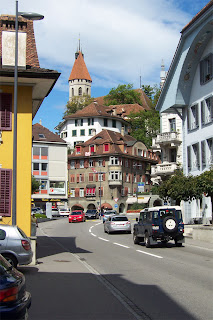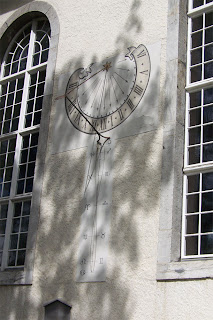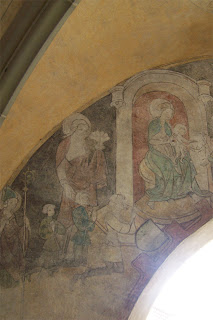
First - My apologies to Mark Twain
Second - I know this is off topic, having nothing to do with my impressions of Saudi Arabia, or my escapes to other exotic climes.
Third - since their usually has to be a third, The 3 Musketeers, The 3 Stooges, The Holy Trinity ... well, actually, I've got no third.
With all the wild talk going on about how Washington is taxing us all to death (no income taxes here in Saudi, since the oil sector is nationalized and the huge revenues are spent for the benefit of the citizens, providing free education and low cost health care, as well as huge new infrastructure projects. Maybe we should try nationalizing some of our natural resources in the USA...) and lots of statistics and graphs being thrown around I thought I'd write a little something about how to use the "truth" to deceive, especially with regard to graphs.

Napoleon is attributed with saying that a picture can tell 1000 words. I would suggest that a picture can also tell 1000 lies.
I saw a chart yesterday that shows the scandalous growth in income tax revenues collected by the IRS. I recreate it here.

The chart is in millions of dollars. So that low figure is $131 Billion. The high figure is $1.164 trillion.
Some of you may find the chart more meaningful if we put it in percentage terms.

From this chart you can see the revenues actually increased by almost 900%.
SCANDALOUS!!!
Well, what does this chart NOT tell you?
In court, when you're standing in front of the judge you have to "tell the truth, the WHOLE truth, and NOTHING BUT the truth". Leave any of those out and you can deceive while telling "the truth".
This chart is not telling the WHOLE truth by a long shot. First of all it's telling you nothing about inflation. Second, it's telling you nothing about about population growth over the period.
Here's the same chart, but taking into account inflation.

All the sudden 884% becomes about 250%
Inflation is real. It makes a difference. Back in 1976 you could buy a gallon of gas for 60 cents. Remember that?
There's still something important missing, population. Revenues have gone up, but so has the population. What does this mean at an individual level? After all, that's what it's all about, isn't it?
Here's the chart, factoring in population growth.

Where does that leave us? What does this all mean? In short, compared to 1976, the Federal government collects 23% more revenue, per person, through income taxes. That's all it means. Nothing more. We're a long way from that horrifying spectacle of 884% increases.
(An aside... has our "standard of living", in purely monetary terms, increased more than 23% since 1976? I would argue yes. We have longer life spans, more cars, more gadgets, bigger houses, etc. So the 23% growth in tax revenue probably gets mostly canceled out by this increase in our standard of living.)
There is still a lot of truth that's missing from the above pictures. But this exercise starts to show the importance of taking into account ALL the relevant information, the WHOLE truth.
How about the "nothing but the truth"? Well, this discussion only looks at revenues collected from INCOME taxes. It doesn't discuss any other sources, in particular, capital gains taxes. That's a huge subject. The very rich make much more of their wealth from capital gains and dividends, which have a much lower tax rate. Warren Buffett has brought that to the country's attention very eloquently in the last couple of months.
Another big subject is State and local taxes and fees. When Federal rates are cut, these usually go up to compensate. However, State and local fees tend to burden the very rich far less than you or me. If their sales taxes or car registration fees go up ... well ... whoop de doo. But you and I feel it where it hurts, right in the ... So, cutting Federal taxes can even end up increasing the total tax burden we face.
From a historical standpoint, these charts would be much more revealing if we took them back to 1945, encompassing several economic cycles and periods when income tax rates were MUCH higher than they are today. When I have the time I will extend the charts further back.
Lastly, these charts say nothing about how these tax revenues are collected across the different economic strata. It's ironic that the periods of highest economic growth in the last 60 years have also been the periods with highest income tax rates on the upper brackets. It SEEMS that taxing the wealthy actually makes the economy grow. But does it? Well, we need to look CLOSELY at the numbers to be sure.
THE MORAL, since every tale is supposed to have one...
The next time somebody waves an impressive graph in front of your face, or starts rattling out lots of numbers, don't let your own insecurity with math be your undoing. Don't just nod or shake your head based on whether you think that person holds the same political agenda as you. Instead, say, "Thank you very much." Then take their numbers and give them a good look over. If you're still insecure about your math, it's time to get out the old 8th grade math book (not the new one) and brush up on your fractions and percentages. It's no more complicated than that.
And don't become cynical. Not everyone is out to deceive. Snoop around online and you'll find many people doing the work I've just done. There are a lot of people out there, just like you and me, who want to get at the truth, the whole truth and nothing but the truth. These are honest people who also happen to be good at math.
Until next time...

a note on my sources:
Tax revenue figures are from the White House Office of Management and Budget
Inflation rates are from a study by Robert Sahr, Oregon State University.
For population statistics I used the Census data collected each decade and interpolated the years in between.

















































